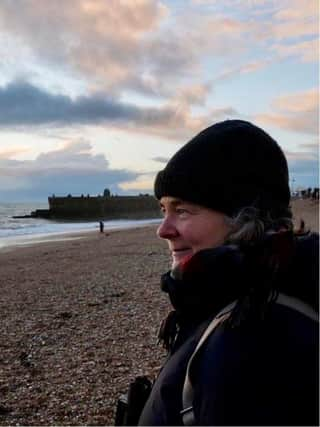Sussex starlings a ‘breathtaking wildlife phenomenon’


The city of Brighton hosts one of nature’s greatest spectacles – starling murmurations, writes Lou McCurdy.
In winter, at nightfall, thousands of starlings gather to perform beautiful, synchronised dances in the sky before swooping down to roost, chatter, and keep warm and safe under Brighton Pier.
Advertisement
Hide AdAdvertisement
Hide AdBrighton’s starling murmurations are a breathtaking urban wildlife phenomenon and the best free show in town.
Add the threat of Brighton’s beautiful resident peregrine falcons, the starlings’ natural predator and the fastest animal on the planet, and you have life-and-death drama unfolding before your eyes.
During the pandemic lockdown of winter October-March 2021 the murmurations gave residents of Brighton a much-needed connection to nature right on our doorstep.
Even in howling winds or freezing rain, I would turn up on the beach with my new starling-obsessed friends – socially distanced, of course –to watch with awe and wonder these huge flash mobs in the sky twisting and turning perfectly together over the sea.
Advertisement
Hide AdAdvertisement
Hide AdAs spectacular as these multitudes seem, though, starlings are in trouble. Between 1970-2018 the UK’s breeding population crashed 82 per cent. The Brighton flock has fallen from 90,000 in 1967 to 10,000 today.
Habitat loss in rural areas, and lack of seeds and insects to eat – the result of intensive agriculture, pollutants and pesticides – are considered the cause.
Starlings are now on the red list as a bird for high conservation concern, declining at a rate of 150 birds an hour since the 1980s.
In November, Brighton Pier opened Starlings Roost – an observation post and café with inspiring information boards.
Advertisement
Hide AdAdvertisement
Hide AdWith more than four million visitors to the pier every year, this permanent exhibition has huge potential to connect the wider public with the starlings and, ultimately, inspire people to protect them.
Live webcams under the pier enable an even greater audience to watch the starlings from the comfort of their homes anywhere in the world.
The more we learn about these creatures, the more wonderful they seem. Why do starlings murmurate? There is strength in numbers. By gathering, flying and roosting together starlings protect each other both from predators and the cold. But they also seem to murmurate for fun, for the sheer joy of flying together as a flock.
Starlings are particularly gregarious and communicative. Our UK birds welcome migratory starlings from Europe seamlessly into their murmurations every year.
Advertisement
Hide AdAdvertisement
Hide AdStarlings have binocular vision and can see colours invisible to the human eye. They have an incredible vocal range of pops, cackles, chuckles and whistles and are masterful mimics, impersonating anything from car alarms to a hawk’s cry.
They have magnetite crystals in their beaks, and magnetite perception in the right eye that can detect the magnetic field in order to navigate at night.
Faced with collapsing resources in the countryside starlings are finding sustenance, now, in the urban environment.
They feast on the seeds of shrubs in gardens, parks and allotments, probe for juicy leather-jacket larvae beneath our lawns, and catch other invertebrates in urban wild patches.
Advertisement
Hide AdAdvertisement
Hide AdBrighton, part of a UNESCO Biosphere Reserve, has gone pesticide-free and the City Council has created wildflower areas on the cliffs at Saltdean – a boost for starlings.
We can all do our bit to protect starlings by supporting pesticide-free agriculture, increasing biodiversity-rich habitats wherever we can, creating scruffier areas in our gardens and providing nesting boxes.
Having been entranced by the murmurations for years, I’m now telling the story of the Brighton starlings in an exhibition Undercurrents with fellow artist Steve Geliot at Phoenix Art Space,Brighton, from January 15-20 Feb 20, 2022 (entry free: www.phoenixbrighton.org/Events/undercurrents).
Expect bird boxes, murmurating text, nests, wunderkammers, prey remains, a unique soundscape and spectacular photographs delving into the ‘wild secrets of Brighton’s murmurations’.
Lou McCurdy is a Brighton-based environmental artist.
For more about Starlings Roost café and the live link to the starlings webcam, visit www.brightonpier.co.uk/eat-and-drink/starlings-roost
Comment Guidelines
National World encourages reader discussion on our stories. User feedback, insights and back-and-forth exchanges add a rich layer of context to reporting. Please review our Community Guidelines before commenting.